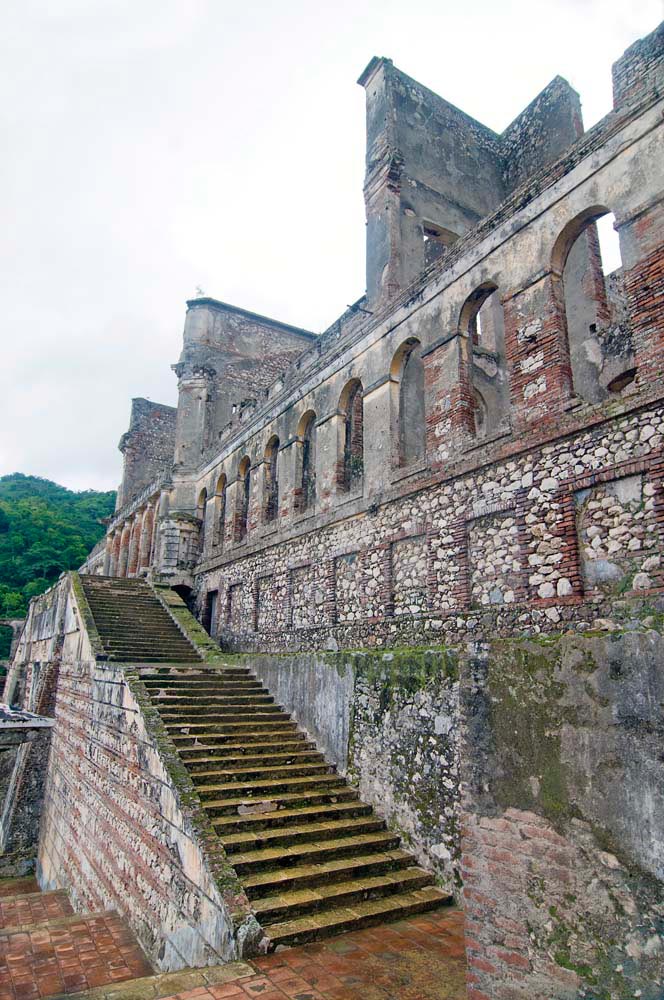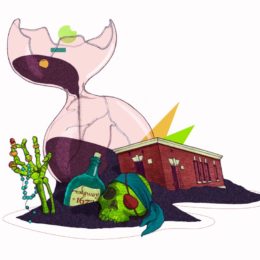Haiti may have the most intriguing history of all the Caribbean islands. Evidence of this is in the ruins of lavish architecture — a palace and a fortress — strewn across the landscape of its far north, near the city of Cap-Haïtien.
The Sans-Souci palace stretches along rolling hills above the town of Milot. It’s one of nine palaces built by Henri Christophe, the second of three post-Revolution Haitian monarchs in the nineteenth century, who fought alongside Haitian liberator Toussaint L’Ouverture before establishing the State of Haiti in the north after the country was split by civil war. (The Republic of Haiti in the south was governed by his nemesis Alexandre Pétion.)
Christophe — or Henri I, as he renamed himself — set up a feudal system with its own nobility, and amassed immense wealth for himself and his kingdom, before a stroke weakened his ability to maintain his iron-fist control and he committed suicide in 1820.
During Christophe’s short reign, Sans-Souci was the site of elaborate gardens decorated with opulent fountains and Grecian statues, magnificent balls attended by splendidly dressed people, wide and winding staircases, expansive terraces, ornate furnishings, a large library with tens of thousands of books (even though it’s said that Christophe was illiterate), a prince’s residence, a network of administrative buildings, stables, a hospital, and a prison. They were all the elements one would have seen in the royal palaces of Europe. But most of the residents of Sans-Souci were black.
Much has been written about Christophe and post-revolutionary Haiti. He was the subject of the first play written by Derek Walcott. But many facts remain disputed, and there’s still a lot to learn.
“It’s a surprisingly poorly understood period of Haiti’s history,” says Professor J. Cameron Monroe of the University of California, Santa Cruz. “I say surprising because it’s the moment right after the Revolution — the most momentous event in the history of the Western hemisphere.”
Monroe is leading a team of archaeologists who are currently working to add to the world’s knowledge about that pivotal period in the first nation to be governed by the formerly enslaved. “I’m not the only person who’s interested in the kingdom of Haiti right now,” he says. “There are many historians who are starting to really comb through the archives for evidence that people have ignored for quite some time.”
The work has more than academic importance. Sans-Souci and another of Christophe’s edifices, the imposing Citadelle — located atop the mountain behind the palace and accessible by hiking or horseback — were designated UNESCO World Heritage sites in 1982, and are key parts of plans to develop the country’s tourism.
Monroe — who specialises in West Africa and the African diaspora around the colonial period — was looking for a new project after wrapping up years of work on the Dahomey kingdom in Benin, and pitched a project on Sans-Souci to Haitian authorities.
“I said, I don’t do tourism. That’s not my skill set. But what I can do is help you understand the site,” he explains. “I can go in and map the site and document the site, and we can excavate in targeted places. That would give you a sense of what’s there — so, for example, if you want to develop the site, if you want to put in the ticket booth, if you want to put in toilets for tourists, [you’ll know] where to dig or not to dig.”
Since 2015, Monroe’s team of around six — made up of Americans and Haitians— has been working through funding from US research grants. It was important to him, Monroe says, that he didn’t look like one of the many opportunists who descended on the country after the 2010 earthquake to “make a buck.”
The team have collected more than fourteen thousand artefact fragments and around 1,300 animal bone fragments, pieces of an archaeological puzzle that, once analysed, will throw light on the lives of Christophe and his subjects.
“He’s building this European-style palace and he’s encouraging everybody to wear these elaborate European-style military uniforms and styles of dress,” says Monroe, explaining one seeming contraction in Christophe’s behaviour. “He’s bringing European music into his court. He really is sending the message to everybody around the Atlantic world that Haiti is a modern nation state on par with all of its contemporaries.
“But when nobody’s looking,” Monroe adds, “he’s eating Afro-Caribbean cuisine. They’re cooking food in clay pots and they’re cooking the kinds of food that people of Afro-Caribbean heritage would immediately identify as familiar.”
The team’s work so far — building on archaeological surveys done in the 1980s by Haiti’s Institute for Protection of the National Patrimony — has also uncovered different layers of construction, which suggest parts of the palace were built, broken down, and rebuilt. “The impression I get is that this is a man who could not stop building, and who could not be satisfied with anything,” Monroe says of Christophe. “He built something, changed his mind, built over it, and changed his mind again. That impresses me — the fact that he’s able to coordinate enough labour and enough resources to invest in this massive effort.”
In additional to traditional excavation, Monroe and his team, in collaboration with experts from the University of Arkansas, have used technology that facilitates “non-invasive” archaeology — that is, no excavating. It’s called ground penetrating radar, or GPR. “It sends a high-density radar wave into the earth, and then if you find any walls or foundations or trash pits or floors — anything archaeological — under the surface, it bounces back. Then you can process that radar data into a map that shows you anomalies across the site,” Monroe explains.
“We use that strategy so that we don’t have to dig so much. It’s a very cost-effective way of going to a site, scanning it for subsurface remains, and then you can be very targeted in where you excavate. Otherwise, you sort of have to dig all over the place to make sure there’s nothing there.”
The idea of a kingdom in the Caribbean may now seem strange and egomaniacal, but at the time it was what formerly enslaved Haitians were most familiar with, both from observing their past European masters and from how societies had been organised in Africa.
“At the time, republics were kind of a weird idea. There were kingdoms everywhere!” says Monroe. “Napoleon was an emperor. We don’t turn our noses up at Napoleon for choosing to be an emperor and for getting rid of the French Republic.”
Christophe’s suicide was the end of his monarchy, and the beginning of the end of the great structures he built. The palace was ransacked, parts of it burned and otherwise destroyed, tiles and other decorative pieces of architecture carted off. An earthquake in 1842 inflicted even more damage. Monroe found that for all Christophe’s obsession with buildings, he didn’t build them to withstand strong quakes. “One of the biggest problems we found is the foundations are incredibly shallow.
“We were excavating one room — it was a two-storey building, probably twenty feet high — and the foundation went down about five centimetres,” Monroe says. “It was literally just built on top of a pile of rubble that was used to flatten the surface, and then they built a tiny, little foundation and put massive walls on top of that. So an earthquake hits that and it’s just going to jiggle like jello and the whole thing falls over.”
This made the building vulnerable then — and now. The destruction of the magnificent National Palace, the president’s residence in Port-au-Prince, by the 2010 earthquake spurred an interest in protecting the country’s monuments that helped make Monroe’s efforts welcome.
“I’m terrified what would happen if Cap-Haïtien gets struck by an earthquake like the one in Port-au-Prince,” he says. “The site might not exist in ten years. That’s a worry of mine.”




















